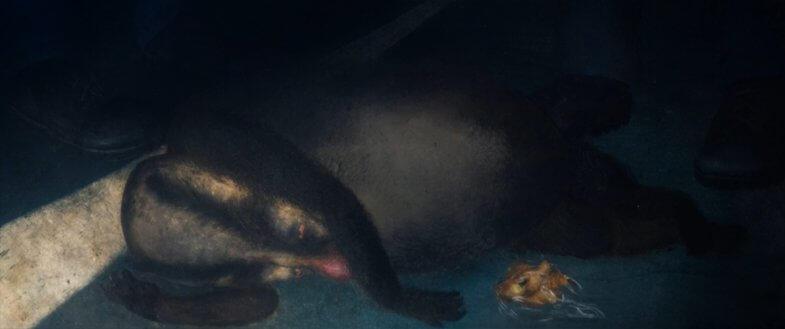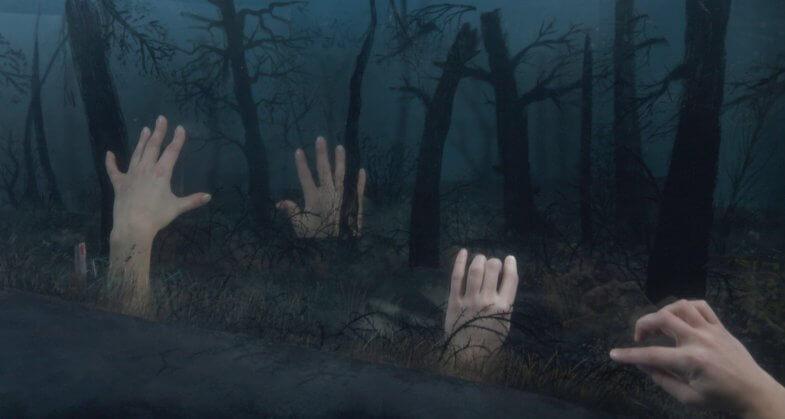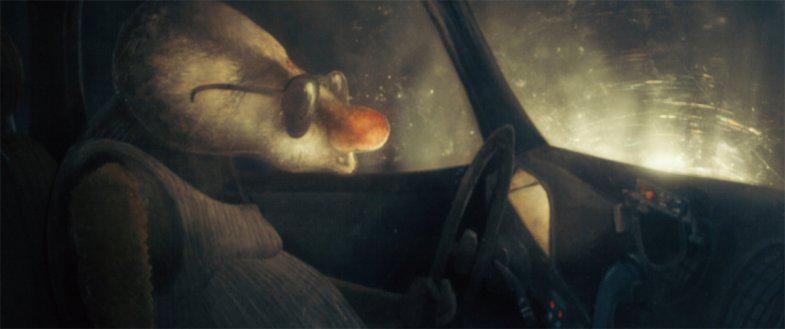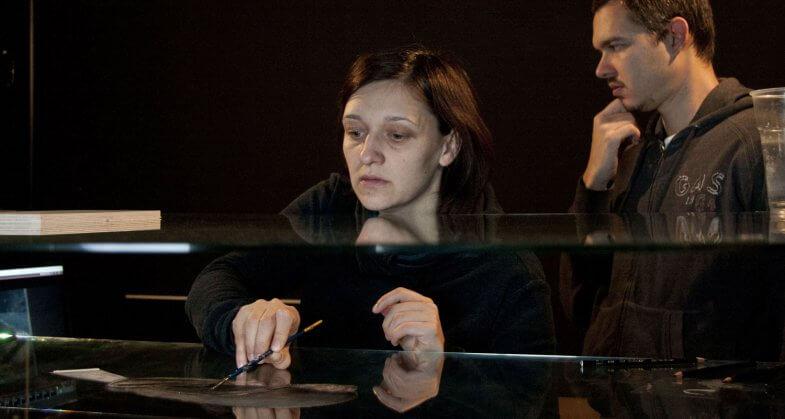Interview with ‘Nighthawk’ director Špela Čadež
UPDATE (01/2019): Nighthawk is now available to watch online in full.
Nighthawk is the phenomenal new film by Slovenian director Špela Čadež, whose previous films include Boles and Lovesick. Her latest film is dark and atmospheric, following an intoxicated badger whose drunk driving leads to distressing consequences. This film’s gritty aesthetic was created with the use of a multiplane camera set up, Špela managing to create a visual experience akin to the work of Yuriy Norshteyn but with modern sensibilities to its narrative and themes. Combining traditional and experimental techniques to great effect, Nighthawk evokes feelings of anxiety and delirium, capturing the feelings of drunkenness in imaginative and creative ways.
Created by a small crew in association with the Finta Institute of Contemporary Arts and Croatia’s Bonobostudio, the film has gone on to be screened internationally at major festivals including Sundance, Annecy, Clermont-Ferrand, the Ottawa International Animation Festival, Animafest Zagreb (where it won the short film Grand Prix), Imaginaria (Best Animated Short Film), GLAS (Best Narrative Short) and Holland Animation Film Festival (Narrative Short Grand Prix) with upcoming screenings including Bristol’s Encounters Short Film and Animation Festival this month and KLIK Amsterdam in October. We’re delighted to welcome Špela Čadež back to Skwigly and learn more about this captivating project.
What inspired you to create such a dark story this time around?
I didn’t originally intend for it to be as dark as it is. I’m always worried when I watch it on the screen as I’m never sure if people are going to be able to see anything as it is, literally, so dark! It’s a dark film about alcoholism, it’s was a dark part of something I was dealing with in my life at the time so I decided to do a film about it.
Why did you pick you badger as your central character?
Actually one of the main reasons is because it was based on a short story from a newspaper, a light comedy story about a drunken badger that was making a mess on the street – when the police came they thought it was dead, but then they saw it was dead drunk. The thing that got me wasn’t that it was a drunk animal but the quote from the policeman which was “this guy will get in trouble when he gets home”. This was meant to be a funny joke, but for me having alcoholism in the family really isn’t funny, so it’s about how society treats people with these kind of troubles. That’s what made want to tell the story and why I used a badger for my central character.
You used multiplane camera technique with an incredible amount of success, can you tell me more about the process, and why you wanted to work in this way?
I had always wanted to try the technique because it’s wonderful, it has so many options. I’ve worked with puppets before, so it’s still stop-motion and you’re able to play with lights, which I love. With the mulitplane you’re open to more space; with puppets you’re kind of limited to the sets you can build but in multiplane you can paint what ever you want and make so many layers. I made shadows with coffee, for example, it’s so experimental. Sometimes it can be frustrating because you can’t find a way to get the visuals as you want them yet on the other hand you can bring you lasagna dish from your apartment and suddenly everything works! That was one of the biggest tricks on this film actually. So this is what tempted me to try this style, I’m still very new to it all and willing to try things. I’m lucky to have a beautiful multiplane table in the studio.

Nighthawk (Dir. Špela Čadež)
Did you buy or make your own multiplane set up?
Actually Slovenian National Television wanted to throw away this really old beautiful table because it wasn’t being used, then Slovenian animators heard about it. At first the Academy of Fine Art wanted to take it but they then said it was so old that nobody would use it, so a professor of mine called me up and said he thought it would be crazy of me not to take it. I had no space at that time, I was 8 months pregnant and it’s over 200 kilos – and I said “Of course I’m taking it!”
The next day I was there with a bunch of friends and we put it in a garage. Then it was a real struggle for my producer and I to find a space where we could afford to keep it between production. It’s always an issue when you don’t have things in production and you still have to travel the world to promote your work as no one finances you for that, so we were really lucky to get a city hall, but it was a real struggle. I think it took a year and a half of begging and knocking on doors. We were lucky that my last film Boles had a a lot of success, in the end that was what secured us space. So now we have this space for free and as long as we want.
Did you recive any funding in order to produce Nighthawk?
Yes we did, in Slovenia there is a national film fund and some money from Slovenian television. We really wanted it to be a German co-production but we didn’t receive any funding from there, so then we found some in Croatia which allowed for the post production.

The multiplane environment of Nighthawk
What was the hardest and best thing about working in this way?
With this film it was difficult because it had no real structure. Because it was so abstract, just pictures in mind of what I wanted, I was far away from being able to storyboard or even describe them. So it was hard to communicate to the animators what I meant at different parts. It’s a very particular type of film as there’s not a lot happening but it’s quite long. So that was the hardest part.
The parts of the film where we see the road form the badger’s point of view, are particularly strong visuals of what it’s like being drunk. How was that visual achieved?
It was on on the multiplane, which is where that lasagna dish I was talking about earlier comes in. If I wanted to get a really drunken atmosphere I would put a really thick-glassed lasagna dish in front of the camera and move it a little, which made the picture out-of-focus and spacey. We also used a lot of Vaseline which was another trick I really liked because you can then animate light effects. It even allows you to manage which direction a glow will go in. It’s a really good technique in that it’s primitive but effective.

Nighthawk (Dir. Špela Čadež)
It must be very exciting and refreshing to work in such a traditional, hands-on way?
For me it’s tempting, the animators we used came from an After Effects background and were using a table for the first time. At the begging they were like “Why are we doing this analogue? This is so easy to do on the computer”. But then, months into the project when I was really tired and said “Let’s just do this bit on the computer” they’d learned that it was impossible to get the same result. And it’s true, analogue still has its own charm.
Did you have much help with the making of the film?
Not really, other than the two animators, one of whom (Matej Lavrenčič) is a really good at drawing and brilliant with perspective, so that was his other job and the other animator (Zarja Menart) was great with texture. In the end it was just me as we couldn’t afford to keep either of them on anymore, as the project went on a lot longer than we planned.

Špela Čadež (director) and Matej Lavrenčič (animator)
How was it to see the film screened at Annecy recently?
It was amazing and I think the audience liked it a lot. When my last film was screened their big cinema was under refurbishment at the time, and I love that cinema so this was very special, to sit there with this very critical audience in this big cinema.
Will your next film be muiltiplane?
My next film is multiplane, I have a really great script that I’m very excited about but I’m in a really fun place right now looking for finance for it first. This is my reality at the moment, the money in Slovenia is getting less and less and I can only apply for one third of the money I need as that’s the maximum I’m allowed. It’s a bit frustrating to have two films behind you yet have the funding still be hard.
Multiplane is enjoying a bit of a renaissance at the moment it seems, what are your thoughts on that?
I think it’s great! I think Yuriy Norshteyn obviously owned this technique and of course he is a great inspiration but it’s a technique that is valuable in its own way without copying him. It’s not so easy to make, you can’t be really fast as once you have all your layers in place it needs a lot of time and prep with lights and rigs, we really need a week to make it all look good and then shoot it in a couple of hours.
UK festivalgoers can catch Nighthawk in the Encounters festival screening Horror: Thrilling and Chilling on September 20th at 10pm.
Visit Špela Čadež online at finta.si

